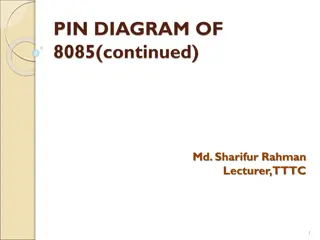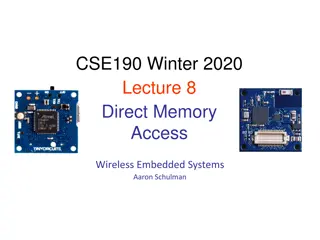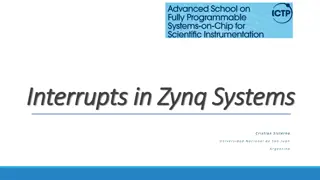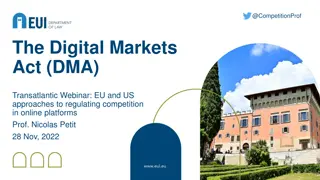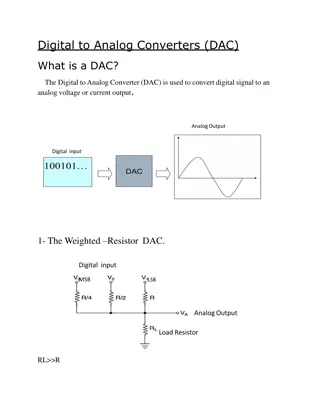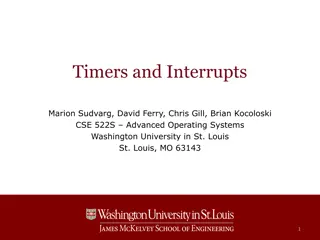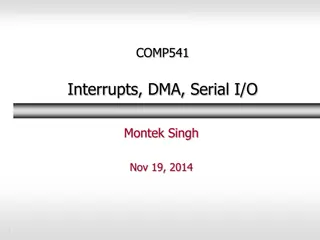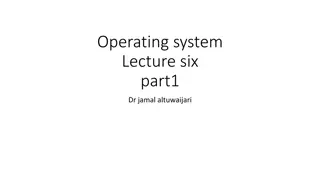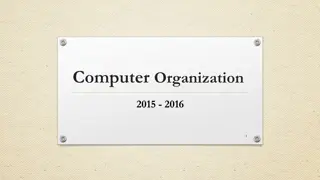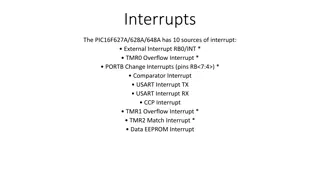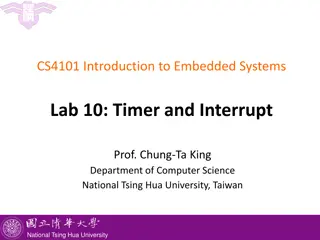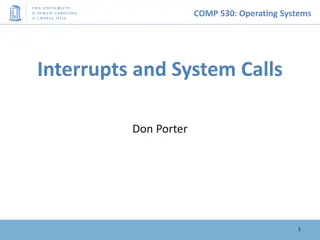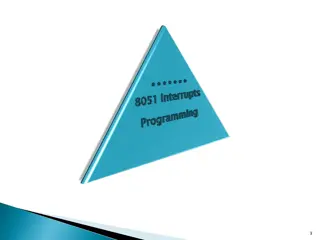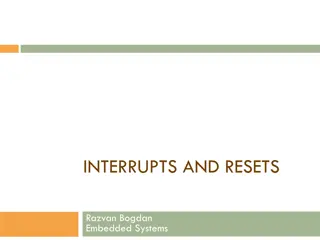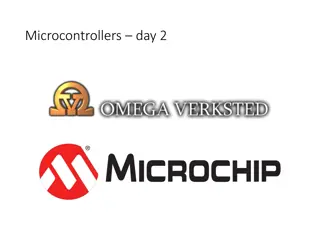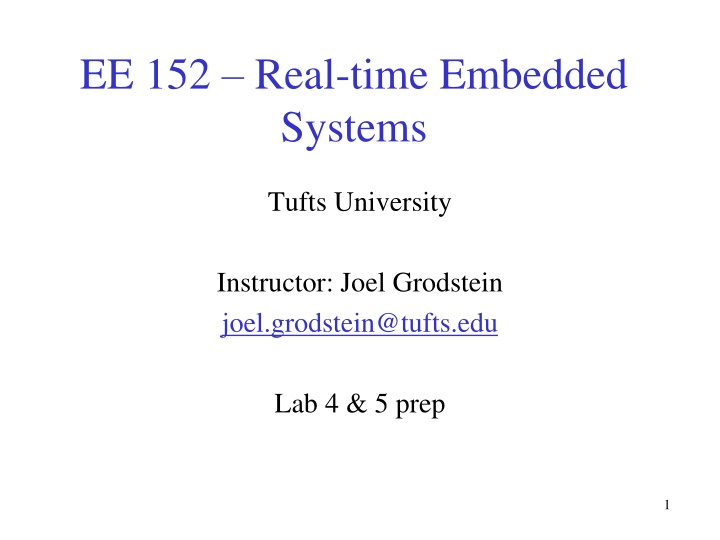
Real-Time Embedded Systems Lab Prep: Debugging Tricks and Topics Overview
Prepare for Labs 4 & 5 of EE 152 Real-Time Embedded Systems at Tufts University with insights into debugging techniques like single-stepping in the debugger, comparing HAL with CMSIS CSRs, and instrumenting FreeRTOS for task-switch debugging. Explore important topics such as Digital to Analog Converters (DACs), Two's Complement, DMA, and Timers. Understand the significance of two's complement representation for negative numbers in computer arithmetic and learn about unsigned and signed integer operations. Delve into the case study of DACs in digital-to-analog conversion with the STM32L432 microcontroller.
Download Presentation

Please find below an Image/Link to download the presentation.
The content on the website is provided AS IS for your information and personal use only. It may not be sold, licensed, or shared on other websites without obtaining consent from the author. If you encounter any issues during the download, it is possible that the publisher has removed the file from their server.
You are allowed to download the files provided on this website for personal or commercial use, subject to the condition that they are used lawfully. All files are the property of their respective owners.
The content on the website is provided AS IS for your information and personal use only. It may not be sold, licensed, or shared on other websites without obtaining consent from the author.
E N D
Presentation Transcript
EE 152 Real-time Embedded Systems Tufts University Instructor: Joel Grodstein joel.grodstein@tufts.edu Lab 4 & 5 prep 1
Debug tricks so far Single step in the debugger to examine variables, CSRs, Compare HAL with CMSIS CSRs to debug either Pause in the debugger to find which infinite loop you re stuck at Instrument FreeRTOS for task-switch debugging Save debug info into a data structure for later printout EE 152 Joel Grodstein 2
Topics for this slide set Digital to analog converter (DAC) Two s complement also! DMA A bit on timers EE 152 Joel Grodstein 3
Prequel twos complement What is two s complement? A way to represent negative numbers on a computer Why do we care? Most all arithmetic uses two s complement But DACs don t! This can bite you in the foot if you don t understand it EE 152 Joel Grodstein 4
Unsigned int Assume for simplicity we have only 4-bit ints 16 bit patterns (0000, 0001, , 1111) For uint4_4 0000 0 0001 1 1111 15 = 2 So we get [0, 24-1] But what if we want negative numbers? EE 152 Joel Grodstein 5
Signed int For int4_t 0000 0 0001 1 0010 2 0111 7 So we get [-8, +7] The secret decoder ring: -x = ~x + 1 1111 -1 1110 -2 1001 -7 1000 -8 EE 152 Joel Grodstein 6
Why do it? Signed arithmetic works fine! (-2) + 1 1110 + 0001 = 1111 = -1 (-2) + (-3) 1110 + 1101 = 1011 = -5 4 + 5 = 0100 + 0101 = 1001 = +7 !!! The CPU doesn t care if we re adding signed or unsigned numbers Now on to DACs EE 152 Joel Grodstein 7
Case study: DAC DAC = Digital to Analog Converter two DACs on our 32L432 digital in 0-max Arduino API: writeAnalog (pin, value) if pin is a DAC pin (432 has PA4, PA5, sets voltage value is in [0,255] (and [0,1023] for analogRead()!) Nothing to it analog out 0-3.3V DAC EE 152 Joel Grodstein 8
DAC precision If we set up the DAC in 8-bit mode.. it wants data in [0,255] What if we give it 256? What if we give it -1? Moral of the story: make sure your data is in range before giving it to a DAC 256 = 0x100 -1 = 0xFFFFFFFF EE 152 Joel Grodstein 9
Lets make it complex Look at the CSR list for the DAC (reference manual 19.7) There are 20 CSRs for our simple DAC! Quick look at the first two DAC_CR (the control register) is complicated! DAC software trigger register is simple EE 152 Joel Grodstein 10
What are those CSRs doing? Any fool can make something complicated. It takes a genius to make it simple Woodie Guthrie What is all this? EE 152 Joel Grodstein 11
Complexity: sample/hold The sample/hold is nice to save power not available on Arduino saves power (at some accuracy cost) EE 152 Joel Grodstein 12
Output buffer Output buffer is useful sometimes not available on Arduino more drive strength (but more power, nonlinearity) EE 152 Joel Grodstein 13
Triggers and DMA Not available via Arduino API We ll use them in labs 4 & 5 EE 152 Joel Grodstein 14
Economics You don t have to use these features but you ve already paid for them! EE 152 Joel Grodstein 15
Another CubeMX demo Show how to initialize the DAC EE 152 Joel Grodstein 16
Canned ECG driver on Arduino Here s an Arduino version for (int i=0; i<1024; ++i) { analog_write (DAC_out_pin, ECG_array[i]); delay(1); // 1ms } Any issues with this code? Spin wait in delay() uses the whole CPU! Any suggestions? Arduino doesn t make threads easy Interval between points is >1ms Any ideas why? EE 152 Joel Grodstein 17
Our own function generator Goal: drive out a sample ECG waveform to a pin Lab 4: simple sawtooth with FreeRTOS Lab 5: simple sawtooth with FreeRTOS + DMA Lab 7: drive a canned ECG to a DAC pin EE 152 Joel Grodstein 18
Lab 4 Lab 4 uses a DAC to drive a sawtooth wave Timing comes from FreeRTOS ticks void task_sawtooth (void *pvParameters) { loop analogWrite (A4, val); vTaskDelay(1); } Brainstorm how to write this task Given a desired sawtooth frequency, how does val get set? What if the period isn t a multiple of 1ms? What s the upper frequency limit? Class exercise EE 152 Joel Grodstein 19
Ready for lab #4! EE 152 Joel Grodstein 20
Triggering and DMA Our plan so far has been SW writes a value to DAC_DHRxx Use FreeRTOS to make sure SW executes every x ms Any reasons this may not be good enough? EE 152 Joel Grodstein 21
How bad is it? We want to use FreeRTOS + DAC to build a sine wave Assume we need 10 points per cycle for a reasonable sine wave What is the max frequency we can create? What is the upper limit of human hearing? Quick in class exercise EE 152 Joel Grodstein 22
More general issue We may want to respond to an external event with <1ms latency How would we do this? Schedule a high-priority function every tick to check for the event not good enough Polling spin loop wasteful Big question: how do we work with time events at a smaller interval than the FreeRTOS tick? How do we do it without spin-wait polling or lots of CPU resources? EE 152 Joel Grodstein 23
Todays solutions Hardware timers Create a signal at a fixed interval And any special sauce a manufacturer adds Interrupts Respond to an event by jumping to a handler routine A.k.a. an interrupt handler DMA Direct memory access Transfers blocks of data without per-datum code EE 152 Joel Grodstein 24
STM32 timers TrgO Clk Counter with auto reload Output channels To GPIO Prescaler Prescaler = divide by N1, to get a slower clock Counter = count to N2, then start at 0 again Trigger Out = can send a trigger to, e.g., a DAC (e.g., on counter reload) Output channel(s) = high on counter match, high on counter < match, toggle on match, Full details: see application note AN4776 EE 152 Joel Grodstein 25
STM32 timers TrgO Clk Counter with auto reload Output channels To GPIO Prescaler Prescaler = divide by N1, to get a slower clock Counter = count to N2, then start at 0 again Trigger Out = can send a trigger to, e.g., a DAC (e.g., on counter reload) Output channel(s) = high on counter match, high on counter < match, toggle on match, How would you build a PWM? Sequence multiple robotic arms in a custom sequence? EE 152 Joel Grodstein Classroom exercise 26
Lab 4 slow architecture FreeRTOS tick execute task Send new value to DAC Pro: simple, requires just a DAC driver and FreeRTOS Con: only one point / ms EE 152 Joel Grodstein 27
Faster architecture Timer TrgO Trigger DAC Copy DAC_DHR DOR Previously: DAC triggers when we write to xxx CSR Now: set DAC to trigger on timer TrgO Pro: can trigger the DAC super frequently Obvious issue: where does it get the values from? EE 152 Joel Grodstein 28
Triggering Trigger can run up to >10 MHz Each trigger transfers DAC_DHRxx to DAC Timing is quite reliable Any obvious problems with this idea? EE 152 Joel Grodstein 29
Get data to DAC: interrupts We trigger the DAC and it starts converting DAC_DOR DAC triggers a particular interrupt Interrupt indexes into an interrupt table to find a handler Whatever code is running gets interrupted, handler runs instead our handler sends new data DAC_DHR When handler finishes, previous code resumes EE 152 Joel Grodstein 30
Faster architecture Trigger DAC Copy DAC_DHR DOR Trigger interrupt Timer TrgO Handler runs Copy data DHR Returns Pro: it all works, and fast Con: interrupt handler adds complexity, uses CPU EE 152 Joel Grodstein 31
Get data to DAC: DMA DMA = Direct Memory Access You write CSRs to set it up. Then Can move entire memory block(s) by itself Memory to memory or memory to a CSR Circular operation if desired Operation for us Timer tells DAC to take a new value from DAC_DHRxx DAC tells DMA it wants data DMA sends next data to DAC rinse and repeat EE 152 Joel Grodstein 32
Faster architecture Trigger DAC Copy DAC_DHR DOR Request DMA item Timer TrgO DMA machine Copy *mem_ptr DHR ++mem_ptr, circular Pro: takes no CPU time Con: must program the DMA controller Con: limited to simple data transfer, not arbitrary code EE 152 Joel Grodstein 33
STM32 DMA controller Traditional use: memory-to-memory xfer without CPU overhead not many use models for controllers? in fact, it s common for us Remember: all our CSRs are memory mapped Common controllers use model: move lots of data between CSR-to-memory or memory-to-CSR what examples of each can you think of? EE 152 Joel Grodstein 34
STM32 DMA controller Two independent DMA controllers Each one has 7 channels each channel can do an independent full transfer! Why might we want 14 different DMA xfers at once? You might have xfers for multiple DACs, ADCs, GPIO, USB, Peripheral speed << CPU speed So we can manage multiple xfers all nicely interleaved with no trouble. And still run code too Yes, DMA is cool EE 152 Joel Grodstein 35
Channel priorities Two independent DMA controllers, each with 7 channels each channel can do an independent full transfer! only one channel per controller can move a datum at a time What if two peripherals want service at once? You assign each channel priority (1-4) EE 152 Joel Grodstein 36
Kicking off a transfer How do you initiate DMA? in mem mem mode, you just program it & kick it off in mem CSR or CSR mem mode, peripheral must request each datum (why do you think that is?) Any usage models (even unintended ones ) where DMA might not be able to keep up with the peripheral? Sure. Coding bugs where you mistakenly set a channel to low priority Result: DMA underflow error. For our DAC example: a new timer trigger arrives without DMA providing new data EE 152 Joel Grodstein 37
What to program Pick which channel(s) to use Each channel can be triggered by only a few CSRs Programmed by DMA_CSELR Program the channel DMA_CSELR = what triggers each channel (not super clear in the docs; see https://community.st.com/t5/stm32- mcus-embedded-software/stm32l4-dma-setup/m- p/604213 DMA_CCR# = various setup (type, direction, etc) DMA_CNDTR# = transfer length DMA_CPAR# , _CMAR#= peripheral, mem address EE 152 Joel Grodstein 38
Other resources See, e.g., https://vivonomicon.com/2019/07/05/bare-metal- stm32-programming-part-9-dma-megamix Nice overview of some stuff we ve not covered here EE 152 Joel Grodstein 39

